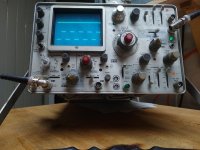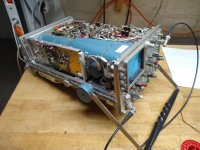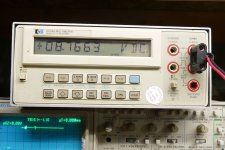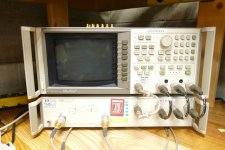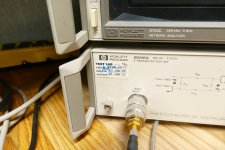Ahhh! Someone else that groks that more digits are bettererr!Looks like we have similar interests and RF backgrounds.
Here's my mess.
Most of the HP stuff was bought in non functioning condition. I fixed most of it and used the others for parts. The network analyzer has a weak CRT so all the bench lights have to be turned off to use it.
The last few days I repaired 3 old oscilloscopes that where otherwise on their way to the dumpster
The last one was a Tek 454A without horizontal sweep. Studying the scanned service manual of approx 300 pages
I encircled the culprit, a JFET inside the sawtooth generator. What a monster of discrete analogue technique,
sometimes I was close to give up
The last one was a Tek 454A without horizontal sweep. Studying the scanned service manual of approx 300 pages
I encircled the culprit, a JFET inside the sawtooth generator. What a monster of discrete analogue technique,
sometimes I was close to give up
Attachments
Yes, it's my nest...
I literally said the F word when I saw that photo. Impressive!
I designed a model railway DCC controller.
A big part of the price was £10 keypad 0-9 * #
I spotted on ali express some keypads for £0.88 each
So got a new pcb made to go with the new keypad layout.
Pcb's arrived from China and I built one up.
Some keys were working ok.
Some were giving the wrong value.
So I checked keypad X and Y connections to make sure I got it right.
Seemed to be right although some keys had a couple of hundred ohms resistance.
I then suspected software was trying to read the key pad too fast.
So I added a small delay after Y scan output and before X scan input.
The keypad now works fine.
A big part of the price was £10 keypad 0-9 * #
I spotted on ali express some keypads for £0.88 each
So got a new pcb made to go with the new keypad layout.
Pcb's arrived from China and I built one up.
Some keys were working ok.
Some were giving the wrong value.
So I checked keypad X and Y connections to make sure I got it right.
Seemed to be right although some keys had a couple of hundred ohms resistance.
I then suspected software was trying to read the key pad too fast.
So I added a small delay after Y scan output and before X scan input.
The keypad now works fine.
Got digits? This is what you need to determine if the 9 volt battery in your Harbor Freight multimeter needs to be replaced. I have several of their cheap meters for poking around in tube circuits. Only blown one in over 10 years.Ahhh! Someone else that groks that more digits are bettererr!
I got a HP34401 with more digits in a pile of dead test equipment that I bought many years ago, but I traded it for a dead (physically damaged) HP8903A audio analyzer just to get a spare CPU card. The 8903A uses HPs infamous SOS process CPU chip which can only be obtained by cannibalization of a dead 8903A. The "B" model does not use the same CPU. The SOS fab went away in the late 80's. I use my 8903A a lot and so far, the CPU has held up, but I have had to swap two other boards in it.
Attachments
My 34401A is one of those that I would never part with - I replaced the display (dim) 12 years ago when I bought it off ePay and it has stayed accurate and pretty much bullet proof ever since. Even though the it and the Keithley are side by side, it is the one I reach for first by default.
This is a General Radio 1432-X decade resistor that I got as part of a GovDeals auction several years ago - I have less than $5.00 in it. The one issue that I have with these (and other decade boxes) is that while the actual resistance elements may be ideal the total readings always include the parasitic resistance of the internal wiring. So the setting may be for 1.00 ohms but the actual resistance will be 1.05 ohms or such. This unit had a residual resistance of .004 ohms and, while small, it resulted in the low values being out of tolerance of the readings. This particular series of resistors uses individual resistors of the same value for all positions for each decade and the switch simply adds them in series. So, on the 0R1 and 1R ranges I added a resistor in parallel with the lowest value to cancel out the 0R004 residual. One thing to note on this is that this correction will reinforce any others in the following decades - you can tweak the lowest range to be perfect but if you select a value using the next (tweaked) range the corrections will be cumulative and the value will be too small. So you have to split the difference to eliminate these errors.
Anyway, not bad results for a 40-50 year old $5 resistance box


Anyway, not bad results for a 40-50 year old $5 resistance box
In the last 12 years of my engineering career at Motorola I worked in a research group. In the last two years our group morphed into an IC design group which spent most of their time simulating and calculating. I was the "let's build something" kind of guy, so it became EVBs and test stations. Taking automated data on custom CMOS RF IC's that span 136 to 941 MHz takes stacks of equipment including lots of 34401As.
The HP 8644B RF generator had the lowest close in (+/- 10 KHz) phase noise of any generator available while I was working there. Shortly after I left in 2014 Agilent / Keysight created something better and the 8644 / 8664 series generators could be found on Ebay for cheap. Often the shipping was more than the generator. I got several of them.
The shutdown of several large engineering facilities around the country including several Motorola plants created a glut in surplus test equipment for a few years and I loaded up on stuff.
The HP 8644B RF generator had the lowest close in (+/- 10 KHz) phase noise of any generator available while I was working there. Shortly after I left in 2014 Agilent / Keysight created something better and the 8644 / 8664 series generators could be found on Ebay for cheap. Often the shipping was more than the generator. I got several of them.
The shutdown of several large engineering facilities around the country including several Motorola plants created a glut in surplus test equipment for a few years and I loaded up on stuff.
The 8644B is a nice piece of kit - I wish that I had tried to get one back when they were available for reasonable prices. My 8663A serves the same needs for me although the PN is not a huge consideration as I mainly use if for level calibrations beyond the 80MHz of my 3335A and it's certainly low enough not to impact those. As for the "cheap stuff" period I am assuming you are talking about the 2018-2021 time period? There was a lot of equipment coming available around then for very little, mostly from the west coast, and I was lucky enough - and able - to be able to get quite a bit at that time including most of my "in-use" gear. TE prices have been steadily rising since then, which is good for all I have in storage that I would like to sell but not so good for the toys I would still like to acquire. While the "sell-offs" tend to happen every handful of years or so I wonder how much vintage gear is left - and if the era of picking up something like the 8644B at an affordable price is over? Newer equipment, yes, but the older classics? Thoughts, anyone?
Hal
Hal
And speaking of rising prices: Calibrations. I had a couple of RF power sensors calibrated in April of 2019; at the time it was $75 for a basic cal and $125 for one with data. Just priced the same thing last week and it was $175 and $425 respectively... ouch! On the same quote a full cal with data for my 8902A/11722A was $2,050. $795.00 + shipping for my Keithley DMM. Seriously? Just crazy...
Hal
Hal
A lot of times during a cal nothing needs to be adjusted, but you have to run a gamut of performance tests to determine if the instrument is within specs firstly.
In your case and as I do, try to determine if the instrument requires any adjust by running the performance tests the best you can with available equipment. In some cases you can do comparisons like measuring 10MHz ovens etc.
Also you need to determine what performance or accuracy you are requiring in your work and if the instruments require that degree of accuracy before you think that you need cal to be done.
I share with George the experience of working in a cal lab at Motorola, I was in Toronto and George was in Boca Raton? In about the same timeframe in the early 80’s. I remember seeing the new 8644 that was the replacement for the 8640 cavity tuned rf generator. I have a 8656B that was once owned by the Motorola RF design group in the Toronto lab. It failed “AM”cal but I have since repaired it, it was the Motorola 10-bit DAC chip, MC3410?
In your case and as I do, try to determine if the instrument requires any adjust by running the performance tests the best you can with available equipment. In some cases you can do comparisons like measuring 10MHz ovens etc.
Also you need to determine what performance or accuracy you are requiring in your work and if the instruments require that degree of accuracy before you think that you need cal to be done.
I share with George the experience of working in a cal lab at Motorola, I was in Toronto and George was in Boca Raton? In about the same timeframe in the early 80’s. I remember seeing the new 8644 that was the replacement for the 8640 cavity tuned rf generator. I have a 8656B that was once owned by the Motorola RF design group in the Toronto lab. It failed “AM”cal but I have since repaired it, it was the Motorola 10-bit DAC chip, MC3410?
Last edited:
One time the boss realized his budget would get cut unless he spent some money, to make it look like his group needed it. So one of the engineers ordered up two pieces of quite expensive Agilent RF gear - for a power supply group. One was a network analyses, with the S parameter test set. I think they got turned on one time, then sat in storage for 15 years, until they closed the place. They eventually couldnt even figure out who it belonged to, from the "cost center" number assigned; I tried to pull / save them and they wouldnt give it to me. Said it belonged to the mechanical engineering group... I'm sure whoever they contracted to take the pile of stuff in entirety got it.
Another time we had to get this Wayne Kerr RLC bridge, because the sister group had one. Someone in that group had written an automated measurement routine for it, which they would provide. Not long after purchase and install, someone bothered to look at the specs and for the inductor values we wished to measure, the best it could do was +/- 50%.
In case anyone wonders where some of this stuff comes from.
Another time we had to get this Wayne Kerr RLC bridge, because the sister group had one. Someone in that group had written an automated measurement routine for it, which they would provide. Not long after purchase and install, someone bothered to look at the specs and for the inductor values we wished to measure, the best it could do was +/- 50%.
In case anyone wonders where some of this stuff comes from.
Yep. My work is designing, repairing and calibrating custom military test stations. One entire series of equipment requires, at best, 0.1% basic DC accuracy... and the equipment the Army specifies to do the calibration? Fluke 5520A calibrators and HP 3458A DMMs. Kinda like requiring a Formula 1 car to bring back a dozen eggs from the corner store. Same for the RF gear - have to use a 175K scope to qualify a 10MHz signal. So, while corporate weenies can play the unnecessary equipment game, the real masters use taxpayer dollars. Sigh.
But it does make for nice toys to play with
But it does make for nice toys to play with
I think that most of my acquisitions were from about 2016 to 2020. Most did come from the west coast, but I did get a couple generators from a used test equipment place in New Jersey.The 8644B is a nice piece of kit....... As for the "cheap stuff" period I am assuming you are talking about the 2018-2021 time period? There was a lot of equipment coming available around then for very little, mostly from the west coast, and I was lucky enough - and able - to be able to get quite a bit at that time including most of my "in-use" gear.
I learned that when you buy an 8643 from a place that sells test equipment for less than $100, expect every board in it to be bad. The 8643A is an 8644A with two SMPS supplies instead of a transformer, and an electronic attenuator instead of an electromechanical attenuator. Phase noise and absolute level accuracy specs are slightly worse than the 8644B. I think that there were two bad boards, both due to shorted tantalum caps and one of the two supplies was randomly inoperative. The intermittent power supply was traced to a bad solder joint on a PC board that had been wave soldered. The lead from a fat wire on an inductor had just enough enamel on it for a bubble to form with no solder adhesion.
Motorola had at least a dozen facilities scattered across two counties in South Florida, though not all of them existed at the same time. Two were large (several thousand people) facilities, one in Plantation and one in Boynton Beach. I worked in seven of them in my 41 year career, but my 10 year stint in the test equipment lab was from 1974 to 1985, and all in Plantation, the largest and longest running facility in Florida. It opened in 1971, and there are still about 250 Motorola employees in a rented section of that building which is now home to the Chewy Dog Food company. There was a "think tank" facility in Boca Raton near the huge IBM plant where the IBM PC was born. I worked there for two years in the early 90's.I share with George the experience of working in a cal lab at Motorola, I was in Toronto and George was in Boca Raton? In about the same timeframe in the early 80’s.
The other large facility was in Boynton Beach Florida about 35 miles from Plantation. It grew far too fast, paid people better than Plantation did, was generous with promotions and bonusses, so I spent a few years there and in several of the satellite plants surrounding it. Like anything that grows too fast, it crashed equally fast and hard. I got a phone call from the guy who ran the Boynton cal lab during the decommissioning of the plant stating that about 1500 pieces of test equipment were slated for the surplus market, but anything needed by any other Motorola plant could be had with some strong backs, a truck, and a person properly situated in the chain of command capable of getting the necessary paperwork filled out, signed, and through the proper process in about three days. After working at 5 different plants for over 30 years, it took me about 15 minutes on the phone to gather all the required stuff.......So one of the engineers ordered up two pieces of quite expensive Agilent RF gear - for a power supply group. One was a network analyses, with the S parameter test set. I think they got turned on one time, then sat in storage for 15 years, until they closed the place. They eventually couldnt even figure out who it belonged to, from the "cost center" number assigned; I tried to pull / save them and they wouldnt give it to me. Said it belonged to the mechanical engineering group... I'm sure whoever they contracted to take the pile of stuff in entirety got it.
Myself, my boss and couple people who had vans were at the Boynton Beach plant the next day. Let's just say that a few things might have escaped from that plant without the proper paperwork to be checked into the Plantation plant the next day, so this stuff had no home. I don't know where any of it went, but this thing that looks like a "network analyzer, with the S parameter test set" sits on my work bench today. It was last calibrated in 2000, and certified to be free of any possible Y2K bugs in case you forgot about that craziness.
Attachments
The boss assigned that one to me, for all the digital stuff in the lab that registered a date. It wasnt that difficult to report back "will be fine" status for each model. Like some of Microsoft's ideas in Windows, it is to wonder how much of the planet's oxygen was wasted on that one.and certified to be free of any possible Y2K bugs in case you forgot about that craziness.
I built my first computer, a SWTPC (of Tiger Amps fame) MC6800 machine that had 4K of ram and an 8 bit CPU that ran at a blazing 921.6 KHz. By 1982 I had a single floppy 5 slot IBM Pc constructed from trunk loads of scrap from the IBM plant where the PC was developed. A bunch of us at Motorola built PC's and there was always a copy of Computer Shopper magazine on someone's workbench. The whole Y2K fiasco began when early versions of DOS only translated the last two digits of the year from decimal into binary when keeping track of the date. This would cause the year 2000 to be translated as 1900. I believe that all of this was fixed somewhere in the DOS 2.X timeframe ad DOS itself had to be improved when the 80286 chip came along to power the IBM PC AT. Any of the Windows NT and Windows 95 and later variants that ran without booting into DOS first were not affected.
In reality the only machines affected were older IBM PCs (five expansion slots which didn't live long enough to be widely cloned) and the more Xpandable IBM PC XTs (8 expansion slots) and clones of the XT. Virtually nobody was running DOS 1.X or even 2.X by the time the computer boom hit hard in the late 80's. There were some hardware devices, including some ATMs that ran an 8 bit CPU which also had the date issue. They were not common and mostly upgraded long before the "end of the world date."
Regardless, Motorola and any other company that built stuff under government contract had to dance the Y2K compliant dance, hence the big "Year 2000 READY" sticker on the network analyzer. It did boost sales for the HPs and Dells of the world though.
In reality the only machines affected were older IBM PCs (five expansion slots which didn't live long enough to be widely cloned) and the more Xpandable IBM PC XTs (8 expansion slots) and clones of the XT. Virtually nobody was running DOS 1.X or even 2.X by the time the computer boom hit hard in the late 80's. There were some hardware devices, including some ATMs that ran an 8 bit CPU which also had the date issue. They were not common and mostly upgraded long before the "end of the world date."
Regardless, Motorola and any other company that built stuff under government contract had to dance the Y2K compliant dance, hence the big "Year 2000 READY" sticker on the network analyzer. It did boost sales for the HPs and Dells of the world though.
Heh. That reminds me of the auction house that wanted me to repair a pallet load of RF signal generators they imported from the USA. I got one working but there were so many faults it wasn't financially viable, and since I was a contractor I just told them to dump the whole lot.I learned that when you buy an 8643 from a place that sells test equipment for less than $100, expect every board in it to be bad.
- Home
- Member Areas
- The Lounge
- What did you last repair?
